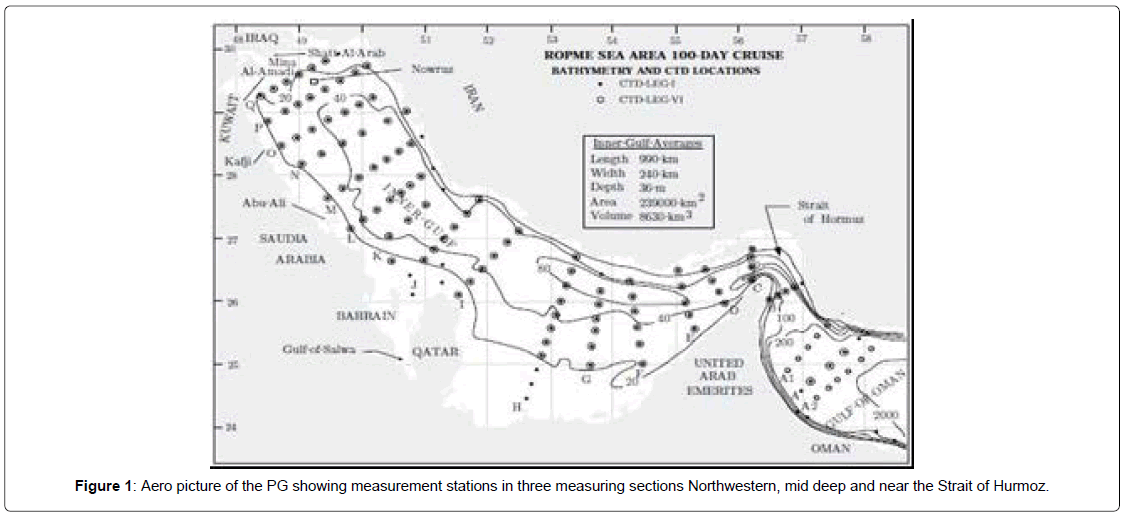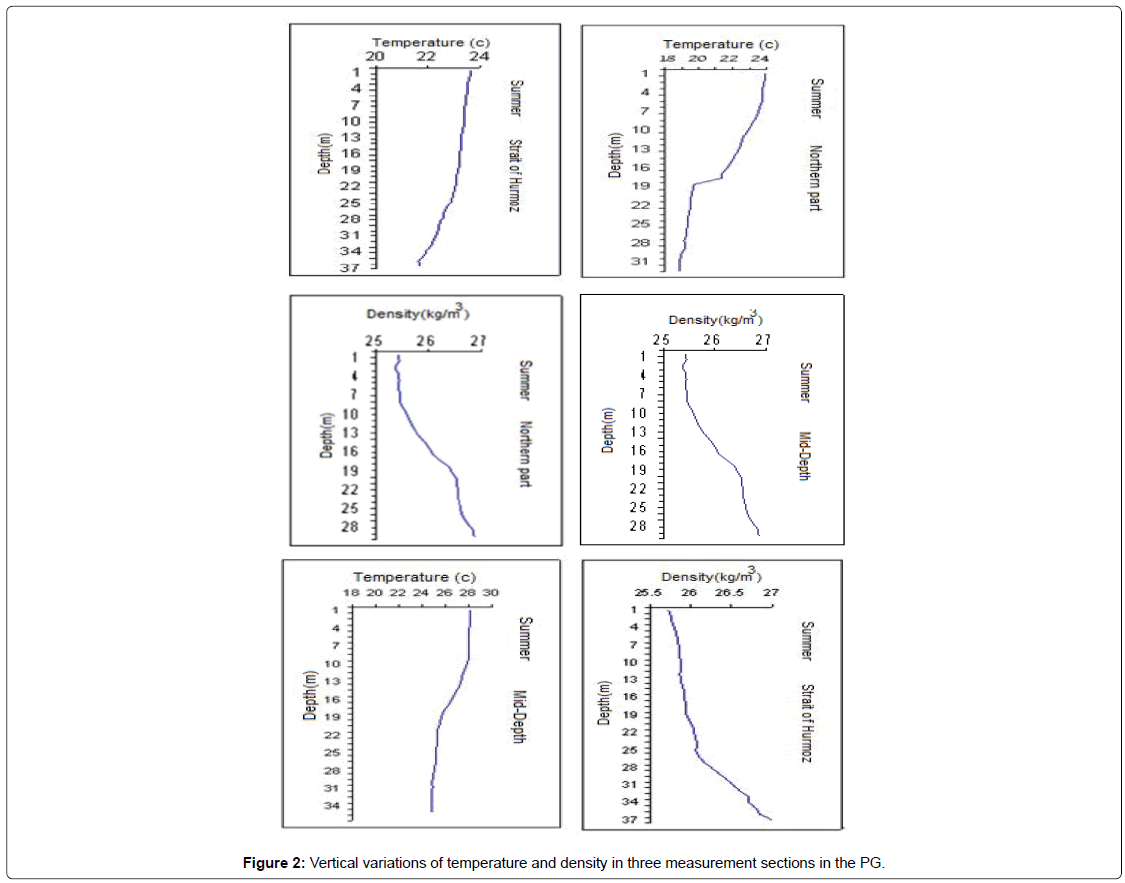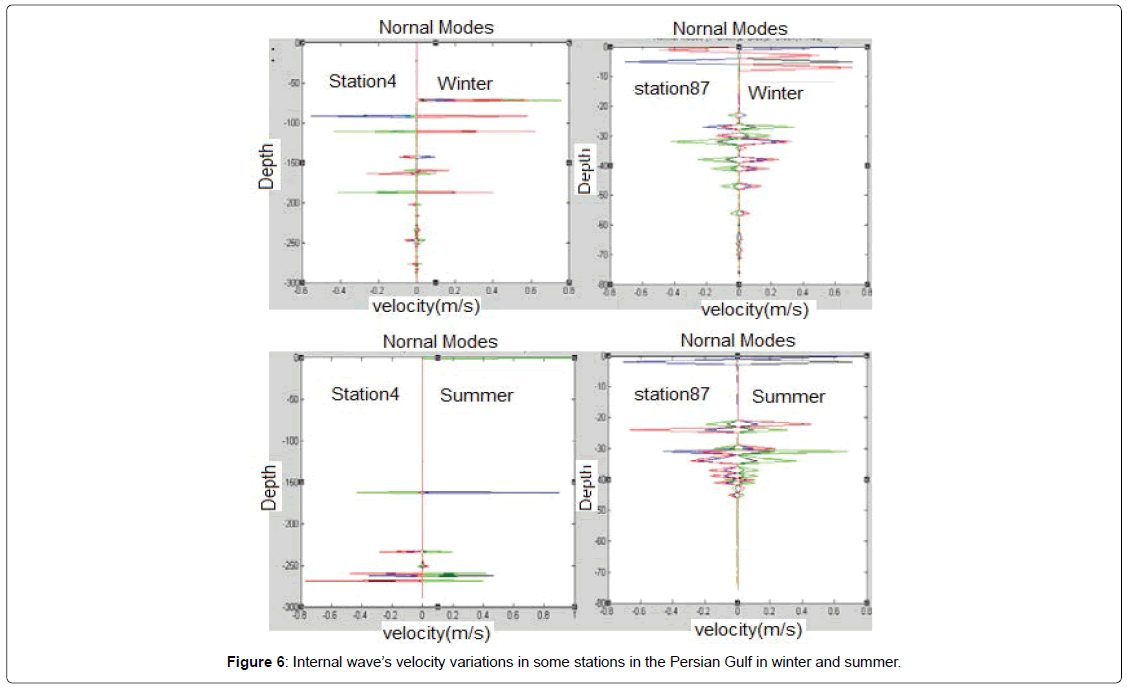Study of Internal Waves in the Persian Gulf
Received: 07-May-2020 / Accepted Date: 26-May-2020 / Published Date: 02-Jun-2020 DOI: 10.4172/2155-9910.1000276
Abstract
The Persian Gulf (PG), as a semi-enclosed water basin extends in (47-57) E, (24-30) N, geographic domain. Particularly, northern part of the PG shows more baroclinicity and turbulence because of the river inflow from the Arvand, bottom and costal stresses. Furthermore, wind stress has many effects rather than in mid deep domain of the PG. Thermocline development in the PG is observed because of studying the data measured in the Mt. Mitchell cruise in 1992 by different models from winter to summer. The studied turbulence in the northern part of the PG is navigated from winter to summer due to the internal wave’s activity and stability intensified through water column.
Keywords: Persian Gulf (PG), Thermocline, Internal Waves, Turbulence.
Introduction
Internal waves play a major role in the formation of seawater stratification and are responsible for the main processes of ocean dynamics, such as energy transfer and mixing [1]. The surface layer is influenced by local wind forcing. The thermocline tries to re-stabilize itself after the cessation of dry season and oscillates for the rest of the year. A main source of turbulence energy is the internal wave field. Some of internal wave energy derives from the transmission of wind energy through the surface mixed layer [2]. The measurement stations in the PG are presented in Figure 1.
An important mechanism for exiting fields of internal gravity waves (IGW) in natural (ocean, the Earth atmosphere) and artificial stratified media is their generation by sources of perturbation of various physical nature, i.e., of natural (moving typhoon, wind waves, flow past the ocean bottom relief imperfections, variations in the density and flow fields, leeward mountains) and anthropogenic )marine technological structures, collapse of the turbulent mixing region, underwater explosions character [3].
Thermocline Formation in the PG
Temperature, density, and salinity are three useful physical properties of seawater to studying. Naturally, the temperature of seawater is fixe at the surface by heat exchange with the atmosphere. Temperature and density vertical variations in some stations in three measurement sections are as in the following profiles in the PG in winter and summer.
The atmospheric disturbance is set by an idealized pulse of cyclonic wind stress with a Rankine vortex structure. Strength, radius and duration of the forcing are varied. The effect upon wave generation of stratification with variable mixed-layer depth is also examined [4]. Relying on the accuracy of the curves in Figure 2, it could be stated that vertical gradient of temperature and density in the subsurface of the water column is very high in the summer but in winter, it is high only in the Strait of Hormuz because of water exchange in winter.
In fact, it could be resulted that thermocline exists only in summer. Overall, the temperature breaks in the subsurface layer through the water column because of wind stress, demonstrates the thermocline developed in the study area. In this regard, thermocline formation and its development are associated to some variations in internal waves, particularly in subsurface layer.
In fact, thermocline development and its variation in space and time represent a turbulent flow, and thus propagation of internal waves through water environment. Turbulence and internal waves propagate along the baroclinic pressure gradient in a vertical direction through the water column due to baroclinicity and tidal wind stress [5]. Based on Figure 2 comparing the curves, we could observe that thermocline does not form in winter, particularly in the Strait of Hormuz because of water exchange with the Gulf of Oman. However, it forms all over the PG through the water column, suggesting that thermocline develops from the Strait of Hormuz to the PG North from winter to summer.
Results and Discussions
The point is that internal waves can create rather strong currents on the ocean surface. The flow is changed depending on the wave extension: its velocity is greater at the wave crest and wave trough and is slower where thermocline oscillations are little [6]. Internal waves in PG in summer differ from winter, due to differences of forcing and factors in summer and winter. Internal waves breaking results in turbulence propagation during winter to summer [7]. Arvand river inflow in northwestern of the PG helps to stratification, and then internal waves and turbulence can form there. Of course, the gradient throughout density contours throughout the PG represents the existence of the internal waves due to thermocline formation, particularly in summer because of high intensity forcing. Wind stress affects the PG surface in the following processes:
1-An atmospheric disturbance causes an internal wave.
2-Turbulence is driven by internal waves shear.
3- Vertical density fluxes are resulted from the mixing.
4- A gravitational imbalance in the horizontal direction includes an intrusion.
5- High wave number internal waves are generated at the head of the intrusion.
Wind stress as a forcing generates an acceleration for water body in vertical and horizontal directions with its components due to shear induced on water [8].
Thermocline forms in the open ocean and can be a seasonal phenomenon in the shallower part of the ocean or a permanent since it is seen in the deeper part of the open ocean. Thermocline is a phenomenon which happens in the Persian Gulf., and it develops from winter to summer resulted of the numerical model (POM) in the PG [9]. Formation of a shallow thermocline with upper mixing and displacements of the thermocline is associated with internal wave propagation, which plays an important role in turbulence generation. The stratification as an important factor influencing on local generation of internal waves in the coastal zones subjected to seasonal variability [10].
In this study, we have wanted to appoint internal waves dependence on thermocline development in the PG, and so will conclude internal waves and turbulence. As in the above profiles, there are fluctuations and variations along vertical T & D; therefore, it could be a crucial result of internal wave's existence [11]. Thus, thermocline development often causes turbulence. We could express that turbulence happens in the PG, because of some forcing all over the PG, such as: tide, wind stress, river inflow. In the PG, baroclinic pressure happens in various stations as in the last profiles [12]. Buoyancy frequency (Brunt Vaisala) as following as baroclinicity and density gradients received by a code in FORTRAN in some stations regarding turbulence and internal wave’s existence are drawn against depth. Figure 3 shows vertical variations of buoyancy frequency in two measurement sections. In fact, in most of the measurement stations, internal waves could form [13].
In fact, more variations through the buoyancy frequency happen in summer rather than in winter, because of more gradients in T and D [14]. The buoyancy frequency is calculated as in the following:
N (z) 2 = (-g/ρ) (Δρ/Δz) (1)
Where w, N (z), w and p (z) are vertical component of internal wave velocity, wave number velocity and mean density function in water column. Depth mean variations for internal wave's velocity (vertical component) profiles in the PG is received as in Figures 4 and 5 in summer and winter with and without bottom stress [15].
In figure 6, profiles of vertical component of internal wave velocity in some points of the PG in winter and summer 1993 depth (m) against velocity (m/s) are showing turbulence in summer because of thermocline develops from winter [16].
Conclusion
Existence of stratification and development of thermocline in the PG is a crucial phenomenon. Summer thermocline formation in the PG is a seasonal potential of turbulence, and internal wave’s creation would happen in the case study zone. Thermocline formation is usually associated with internal waves as an important cause in turbulence.
Internal waves are able to provide and transmit the energy, which is essential for aquatic circulation and mixture. Moreover, in coastal areas that charges in fluid temperature in water column causes diffusion of internal waves.
It could be concluded that:
1-Baroclinic pressure and stratification, cause turbulence throughout PG water column in summer.
2- In summer, turbulent behavior happens. The most effective factors on the behavior in the PG are tide, wind, evaporation, and river inflow.
3- The existence of tides, northwestern winds, and strong internal waves in PG results in high vertical component of internal wave’s velocity.
4- Turbulence and internal waves due to baroclinic pressure because of density gradients exist in the PG water in summer.
5- Vertical component of internal waves velocity has range of [-0.8, +0.8] with more fluctuations in summer.
References
- Morozov E G (2018) Oceanic internal tides. Observations, analysis, and modeling. Springer International Publishing. 10:978-973.
- Alford M H, Pinkel R (2006) Observations of overturning in the thermocline: The context of Ocean, J Phys Oceanogr 30:805-832.
- Bulatov VV, Ladimirov YV (2019) Internal gravity waves from a moving source: Modeling and asymptotics. J Phys Conf Ser 1268:1-12.
- Voelker GS, Myers PG, Walter M, Sutherland BR (2019) Generation of oceanic internal gravity waves by a cyclonic surface stress disturbance. Dynam Atmos Ocean. 86:16-133.
- Delphi M, and Mosaddad S M (2010) Formation of summer thermocline in the Persian Gulf. Int J Environ Sci Dev. 5:429-431.
- Miropol'Sky YZ (2001) Dynamics of internal gravity waves in the ocean. Springer Science & Business Media, Kluwer Academic Publishers, Boston.
- Bidokhti A A, Ezam M (2008) The structure of the Persian Gulf outflow subjected to density variations, J. of Ocean Sci. Discuss, 5:135-161.
- Onogi K J, Tsutsui J, Koide H, Sakamoto M, Kobayashi S et.al. (2007) The JRA-25 reanalysis. J Meteor Soc Japan 85:369-432.
- Mosaddad SM, Bidokhti AA, Basirparsa H (2012) An observational and numerical modeling of thermocline development in the Persian Gulf, J. Marine Geodesy. J Mar Geod. 35:32-48.
- Mosaddad SM, Bidokhti AA, Basirparsa H (2009) Development of summer thermocline in the Persian Gulf. Int J Clim Change: Impacts and Responses. 1:71-80.
- Henning CC, Vallis GK (2004) The effects of mesoscale eddies on the main Subtropical Thermocline. J Phys Oceanogr. 34:2429-2443.
- Moum JN, Smyth WD (2000) Upper ocean mixing. En Ocean Sci. 6:3093-3100.
- Pingree ]RD, Holligan PM, Mardell T (1987) The effect of vertical stability on phytoplankton distributions in the summer on the Northwest European Shelf. Deep-Sea Res. 25:1011–1028.
- Michael ]R (1993) Physical oceanography of the Persian Gulf, Strait of Hormuz and the Gulf of Oman-results from the Mt. Mitchell Expedition, Marine Poll Bull, Pergamon Press, London. 27:35-59.
- Butman B, Alexander PS, Scotti A, Beardsley RC, Anderson SP (2006) Large internal waves in Massachusetts Bay transport sediments offshore. Cont Shelf Res.26:2029-2049.
- Swift SA, Bower AS (2003) Formation and circulation of dense water in the Persian/Arabian Gulf. J Geophys Res Oceans. 108:1-22.
Citation: Mosaddad SM (2020) Study of Internal Waves in the Persian Gulf. J Marine Sci Res Dev 10: 276. DOI: 10.4172/2155-9910.1000276
Copyright: © 2020 Mosaddad SM. This is an open-access article distributed under the terms of the Creative Commons Attribution License, which permits unrestricted use, distribution, and reproduction in any medium, provided the original author and source are credited.
Select your language of interest to view the total content in your interested language
Share This Article
Recommended Journals
Open Access Journals
Article Tools
Article Usage
- Total views: 2936
- [From(publication date): 0-2020 - Nov 09, 2025]
- Breakdown by view type
- HTML page views: 2073
- PDF downloads: 863






